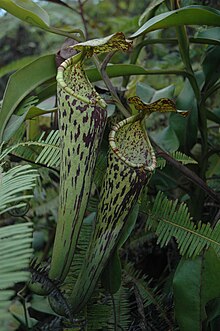| Nepenthes stenophylla | |
|---|---|

| |
| Upper pitchers of N. stenophylla growing along a logging road to Mount Murud | |
| Scientific classification | |
| Kingdom: | Plantae |
| Clade: | Tracheophytes |
| Clade: | Angiosperms |
| Clade: | Eudicots |
| Order: | Caryophyllales |
| Family: | Nepenthaceae |
| Genus: | Nepenthes |
| Species: | N. stenophylla
|
| Binomial name | |
| Nepenthes stenophylla | |
| Synonyms | |
| |
Nepenthes stenophylla /nɪˈpɛnθiːz ˌstɛnoʊˈfɪlə/, or the narrow-leaved pitcher-plant,[5] is a tropical pitcher plant endemic to Borneo.[6] The species produces attractive funnel-shaped pitchers up to 25 cm high.[7] It is listed as Least Concern on the IUCN Red List.[1] Nepenthes stenophylla belongs to the loosely defined "N. maxima complex", which also includes, among other species, N. boschiana, N. chaniana, N. epiphytica, N. eymae, N. faizaliana, N. fusca, N. klossii, N. maxima, N. platychila, and N. vogelii.[8]

- ^ a b Clarke, C.M. (2018). "Nepenthes stenophylla". IUCN Red List of Threatened Species. 2018: e.T39699A143964900. doi:10.2305/IUCN.UK.2018-1.RLTS.T39699A143964900.en. Retrieved 19 November 2021.
- ^ Masters, M.T. 1890. New or noteworthy plants. Nepenthes stenophylla, Mast., sp. n.. The Gardeners' Chronicle, series 3, 8(192): 240.
- ^ (in Latin) Hooker, J.D. 1873. Ordo CLXXV bis. Nepenthaceæ. In: A. de Candolle Prodromus Systematis Naturalis Regni Vegetabilis 17: 90–105.
- ^ (in German) Beck, G. 1895. Die Gattung Nepenthes. Wiener Illustrirte Garten-Zeitung 20(3–6): 96–107, 141–150, 182–192, 217–229.
- ^ Phillipps, A. & A. Lamb 1996. Pitcher-Plants of Borneo. Natural History Publications (Borneo), Kota Kinabalu.
- ^ a b Clarke, C.M. 1997. Nepenthes of Borneo. Natural History Publications (Borneo), Kota Kinabalu.
- ^ Cheek, M.R. & M.H.P. Jebb 2001. Nepenthaceae. Flora Malesiana 15: 1–157.
- ^ Robinson, A.S., J. Nerz & A. Wistuba 2011. Nepenthes epiphytica, a new pitcher plant from East Kalimantan. In: McPherson, S.R. New Nepenthes: Volume One. Redfern Natural History Productions, Poole. pp. 36–51.
